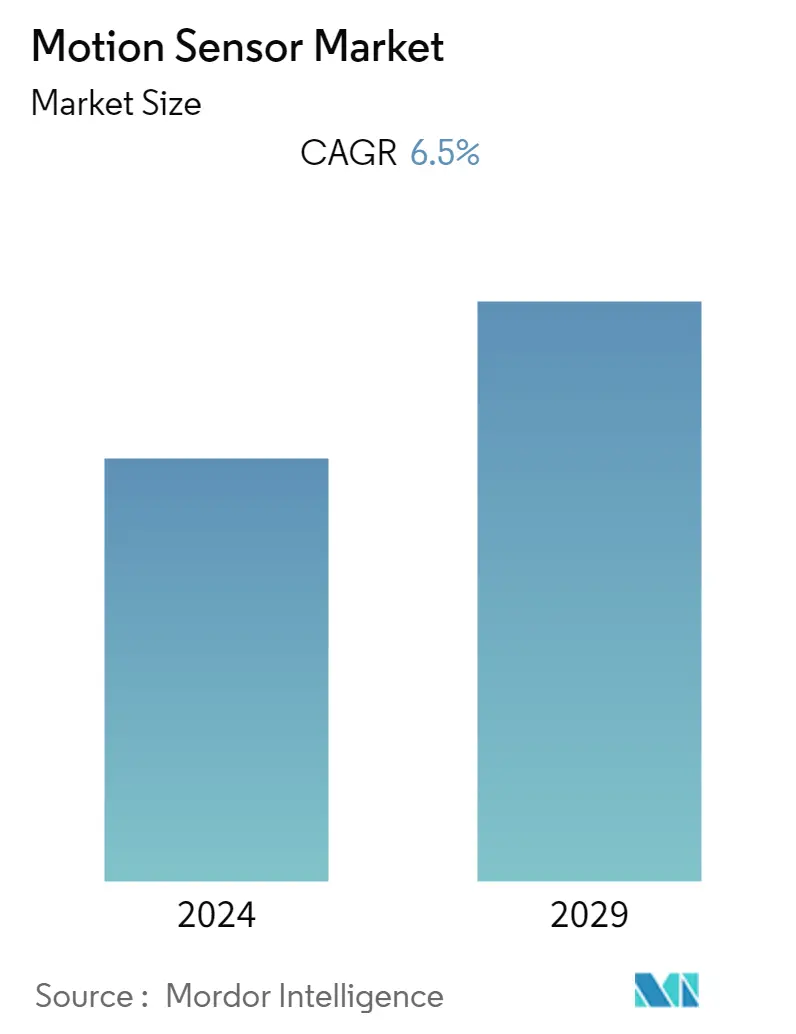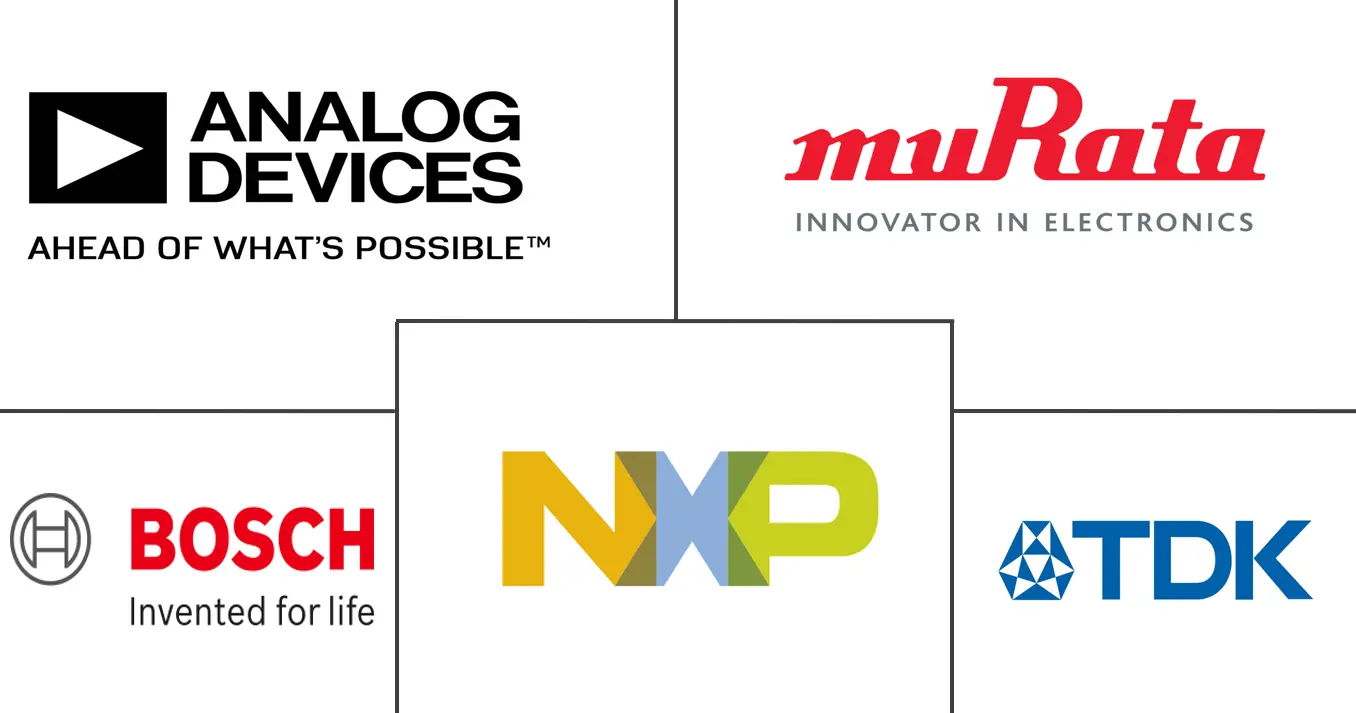Market Size of Motion Sensor Industry

| Study Period | 2019 - 2029 |
| Base Year For Estimation | 2023 |
| CAGR | 6.50 % |
| Fastest Growing Market | Asia Pacific |
| Largest Market | Asia Pacific |
| Market Concentration | Medium |
Major Players
*Disclaimer: Major Players sorted in no particular order |
Motion Sensor Market Analysis
The Motion Sensor Market is expected to grow at a CAGR of 6.5% during the forecast period of 2021 - 2026. Moreover, increasing demand for consumer electronics and the rising adoption of automation technology in various industries will drive the growth of this market.
- Industry 4.0, the newest industrial revolution, has fueled the development of new technologies like collaborative robots, AI-enabled robots, etc., which have enabled enterprises to streamline many processes, increase efficiency, and eliminate errors that support the growth of this market.
- Moreover, sensors such as accelerometers, magnetometers, gyroscopes are widely used in smartphones and tablets. As per the Global System for Mobile Communications (GSMA) data, the global IoT connection is increased by 12.6 billion, which is influencing the growth of this market. the market is expected to experience the vendors investing in innovative/novel solutions to keep drive their market share growth. In 2019 STMicroelectronics, for instance, launched its LSM6DSO and LSM6DSOX 6-axis modules motion sensor, which is configured with finite state machine and machine learning core technology. This innovative technology helps users create their motion-recognition algorithms, and it also maximizes the battery runtime for any smartphones.
- Additionally, different motion games for mobiles are also increasing the demand for motion sensors in the mobile gaming industry. Vendors are expected to launch products in partnership with the supply chain partners to create niche opportunities for them that are end-user industry specific. For instance, in 2019, French company Gameloft launched Asphalt 9, which had already crossed 4 million downloads on Nintendo Switch.
- Furthermore, The motion sensors are ideally suited to various industrial and scientific applications, such as robotics, automotive, and medical research (biomechanical and orthopedics). For instance, Bosch Sensortec recently launched BMA456 accelerometer, which has optimized hearable features integrated with one sensor. This sensor is also able to reduce power consumption and can increase the overall battery life.
Motion Sensor Industry Segmentation
A motion sensor is widely used in smartwatches, wristbands, smart shoes, smart shirts, headbands due to its ability to detect the motion of any object or any human being. The motion sensor is segmented by Technology, Application, and Geography. Moreover, the application segment is further segmented into Consumer Electronics, Automotive, Healthcare, Security & Surveillance, Lighting Controls, Automation, and Other Applications. The study also covers the impact of COVID 19 on the market ecosystem.
| Technology | |
| Ultrasonic | |
| Microwave | |
| Infrared | |
| Dual/Hybrid | |
| Other Technology Types |
| Application | |
| Consumer Electronics | |
| Automotive | |
| Healthcare | |
| Security & Surveillance | |
| Lighting Controls | |
| Automation (Commercial, Residential and Industrial) | |
| Other Applications |
| Geography | |
| North America | |
| Europe | |
| Asia-Pacific | |
| Rest of the World |
Motion Sensor Market Size Summary
The motion sensor market is poised for significant growth, driven by the increasing demand for consumer electronics and the widespread adoption of automation technologies across various industries. The advent of Industry 4.0 has spurred the development of advanced technologies such as collaborative and AI-enabled robots, which have enhanced operational efficiency and accuracy, thereby bolstering market expansion. Motion sensors, including accelerometers, magnetometers, and gyroscopes, are integral to smartphones and tablets, with the proliferation of IoT connections further propelling market growth. Innovations in sensor technology, such as STMicroelectronics' motion sensor modules with machine learning capabilities, are enabling new applications in mobile gaming and other sectors. The market is also witnessing strategic partnerships and product launches aimed at creating niche opportunities tailored to specific end-user industries.
In the automotive sector, the demand for motion sensors is rapidly increasing due to their critical role in micro-electro-mechanical systems (MEMS) and advanced driver assistance systems (ADAS). The compact size and cost-effectiveness of MEMS sensors make them ideal for applications such as airbags and vehicle deceleration detection, contributing to enhanced safety and security features in vehicles. The market's growth is further supported by the rise of electric vehicles and 5G smartphones, particularly in the Asia Pacific region, where government initiatives are promoting the adoption of advanced sensor technologies. The competitive landscape is characterized by the presence of key players like Murata Manufacturing, TDK Corporation, and STMicroelectronics, who are focusing on product innovation and strategic mergers to maintain their market positions.
Motion Sensor Market Size - Table of Contents
-
1. MARKET INSIGHTS
-
1.1 Market Overview
-
1.2 Industry Attractiveness - Porters 5 Force Analysis
-
1.2.1 Threat of New Entrants
-
1.2.2 Bargaining Power of Buyers/Consumers
-
1.2.3 Bargaining Power of Suppliers
-
1.2.4 Threat of Substitute Products
-
1.2.5 Intensity of Competitive Rivalry
-
-
1.3 Impact of COVID-19 on the Industry
-
-
2. MARKET SEGMENTATION
-
2.1 Technology
-
2.1.1 Ultrasonic
-
2.1.2 Microwave
-
2.1.3 Infrared
-
2.1.4 Dual/Hybrid
-
2.1.5 Other Technology Types
-
-
2.2 Application
-
2.2.1 Consumer Electronics
-
2.2.2 Automotive
-
2.2.3 Healthcare
-
2.2.4 Security & Surveillance
-
2.2.5 Lighting Controls
-
2.2.6 Automation (Commercial, Residential and Industrial)
-
2.2.7 Other Applications
-
-
2.3 Geography
-
2.3.1 North America
-
2.3.2 Europe
-
2.3.3 Asia-Pacific
-
2.3.4 Rest of the World
-
-
Motion Sensor Market Size FAQs
What is the current Motion Sensor Market size?
The Motion Sensor Market is projected to register a CAGR of 6.5% during the forecast period (2024-2029)
Who are the key players in Motion Sensor Market?
Murata Manufacturing Co. Ltd, Analog Devices Inc, NXP Semiconductor NV, TDK Corporation and Bosch Sensortec GmbH are the major companies operating in the Motion Sensor Market.

